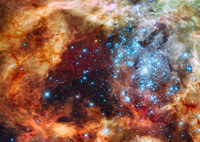BETTII Science Goals
BETTII will offer the combination of high angular resolution and spectroscopy in two far-infrared bands. These capabilities provide unique opportunities for the study of clustered star formation and active galactic nuclei.

Clustered star formation: Much theory centers on how individual stars form from clouds of gas and dust. However, most stars form in groups, or clusters. Much of the energy emitted by these young stars is absorbed and reemitted as infrared by the surrounding dust and gas. Thus, infrared astronomy provides a means to observe features and processes that are invisible in other wavelengths, such as ultraviolet and visible light.
Understanding clustered star formation remains difficult, in part because current instruments lack the resolution to resolve the details of star formation in distant, dense, and dust-obscured clusters. BETTII will provide the detail-revealing angular resolution to distinguish between individual emission sources in clusters. (Angular resolution refers to the ability to discern fine spatial details.)
The main goal of these observations would be to understand the differences between stars that form in clustered environments and those that form singly. The combination of high angular resolution and spectroscopic capability should provide information unobtainable with any existing telescope or instrument in the wavelength regions BETTII observes.

Active galactic nuclei: Active galactic nuclei (AGNs) are compact and unusually bright central regions of some galaxies thought to be powered by supermassive black holes. Astronomers still struggle to understand basic issues about AGN, such as how they form and how they affect star formation in young galaxies.
BETTII will provide new data about AGN not obtainable with existing tools. For example, the ability to do far-infrared spectroscopy at high angular resolution will make it possible to distinguish between far-infrared emission from AGN and emissions from starburst regions farther from the galactic center. Furthermore, BETTII data could help improve models for far infrared emission from different regions of galaxies, thereby making it easier to interpret data from other instruments and observatories.


